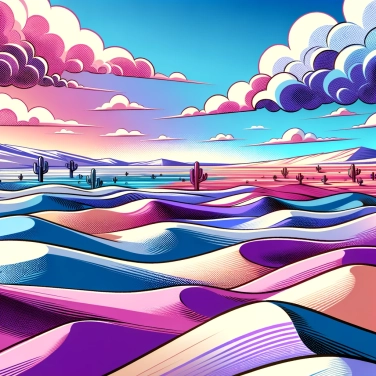Mirages form in the desert due to temperature variations between the scorching ground and the cooler air. These temperature differences cause light to refract, creating optical illusions.

Refraction is simply the bending of light rays when they pass through different mediums, like when you look at a straw in a glass of water that appears cut or bent at the surface. Why this bending? Because the speed of light changes depending on the medium it travels through. In warm air, for example, light moves slightly faster than in cold air, slightly altering its path. The result: your brain interprets these bent rays as if they were coming straight, sometimes creating quite strange optical illusions (like mirages).
In the desert, the ground heated by the sun rapidly raises the temperature near the surface. This warm air then becomes less dense (in other words, lighter) than the cooler, denser air above it. Being less dense, the warm air stays close to the ground, creating layers of air with different densities. It is this difference in air density that causes the refraction of light rays and allows the formation of mirages, giving the illusion of water on the horizon or strangely floating objects in the distance.
Mirages are illusions caused by the refraction of light as it passes through layers of air at different temperatures. An inferior mirage forms when the air just above the ground is very hot. This hot, less dense air gradually bends light rays upward. As a result, our brain interprets this bent light as if there were a reflection on a water surface, even though there obviously isn't one. Conversely, a superior mirage appears when layers of hot air are above the cold air near the ground. This reverse configuration is less common and causes light rays to bend downward. Therefore, we can see objects float in the air that are well beyond the horizon. Fascinating but deceptive!
In deserts, the sand heats up intensely under the sun, with ground temperatures potentially exceeding 60°C. This extreme heat creates a strong thermal gradient, meaning a huge temperature difference between the burning ground and the cooler air above. With this difference, the layers of air near the ground become much less dense, and their density varies rapidly over a short height. It is precisely this abrupt change in density that causes a strong refraction of light rays, which is essential for the formation of mirages. Another characteristic: in the heart of the desert, the almost total lack of vegetation minimizes the humidity in the air. This dry and clear climate facilitates the direct passage of sunlight without obstacles, intensifying its effect on the ground and thus reinforcing the ideal conditions for mirages.
The Sahara Desert is well known for its spectacular mirages, ghostly oases appearing in the distance, giving the impression of water in the middle of the desert. Several witnesses report the regular appearance of false lakes and palm groves, completely deceiving caravanners and explorers for centuries. The same phenomenon occurs in Death Valley, in the United States: this burning desert is famous for its striking optical illusions of non-existent expanses of water on the road or on the arid ground. And it is impossible not to think of the legendary mystery of the Fata Morgana mirage, sometimes observed in desert regions like North Africa, where distant objects seem to curiously float above the ground. These famous cases show how much mirages have shaped travel narratives and contributed to enriching local folklore all over the world.
Contrary to popular belief, a mirage is not an hallucination: it actually occurs and can even be captured in photos or on film.
The term 'mirage' comes from the French verb 'mirer', meaning 'to look closely or contemplate', thus highlighting the visual aspect of this astonishing optical phenomenon.
Some legends of ghost towns or mythical oases in the deserts may have their origins in mirage phenomena observed by tired or dehydrated travelers.
Desert animals, just like humans, can be deceived by mirages, which may lead them to travel unnecessarily in search of non-existent water or shelter resources.
Mirages are visual illusions created by the bending of light rays in layers of air with different densities. As one approaches, the angle and the disturbed layers of air change, altering the trajectory of the light rays, which eliminates the optical illusion initially observed from a different position.
Here is the translation of your text from French to English: "Clearly photographing a mirage can be challenging, as these optical illusions are generally unstable and very sensitive to environmental conditions. However, with the right equipment (a camera with good focus and stabilization), it is possible to capture a relatively sharp image."
The main risk associated with mirages lies in their ability to deceive perception, making one believe there is water where there is none. This can lead to misdirection, thereby delaying travelers or exposing them further to the dangers of the desert, such as dehydration.
An inferior mirage occurs when the air close to the ground is very hot and less dense, creating the image of a body of warm water on the ground. Conversely, a superior mirage forms when the air near the ground is cold and the upper air is warmer, resulting in the appearance of the image above the actual object.
Yes, mirages can occur anywhere that atmospheric conditions lead to significant and rapid variations in temperature. They can thus be observed on heated roads, oceans, or even in polar regions.

0% of respondents passed this quiz completely!
Question 1/5